Open in 2024: May 1-31, June 1-9, Aug 17-25, Oct 1-14, 9am-1pm
Fee: adult €10, OAP/student €5, child free

donation
Help me to pay the entrance fee to one of the houses on this website. This site is created purely out of love for the subject and I receive no payment so any donation is appreciated!
€10.00
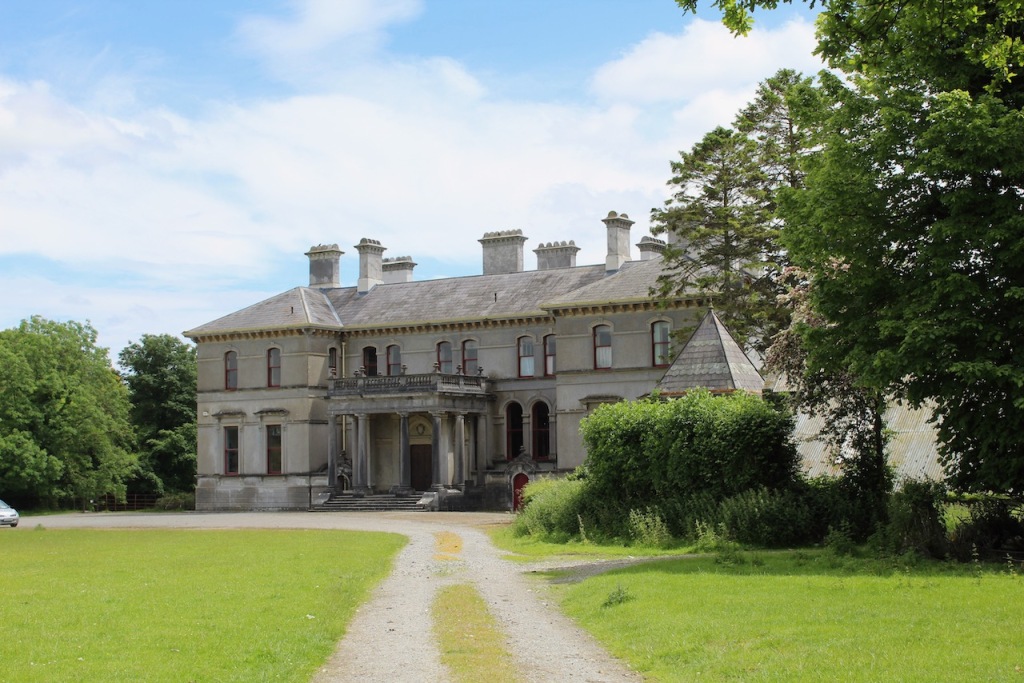
Thomas Cosby kindly agreed to show us his home, Stradbally Hall, in June, despite ongoing Covid restrictions. This year (2021) Section 482 houses are not required to be open to the public due to the dangers of the Covid virus.
Many people have heard of Stradbally nowadays as it is the venue for Electric Picnic. Being the venue for a festival brings in much-needed finances for some of the big houses in Ireland. Stradbally is owned by the same family for whom it was built, and it is magnificent. I can only imagine how hard it is to maintain. Like many of the owners who inherit their big houses, Thomas farms his land.
Mark Bence-Jones tells us in his A Guide to Irish Country Houses that a house was built at Stradbally in 1699 for Lt-Col Dudley Cosby (1662-1729). [1] This house, however, was demolished by the grandson of Lt-Col. Dudley, another Dudley (Alexander Sydney) Cosby, 1stand last Lord Sydney of Leix and Baron of Stradbally, in 1768, and a new house was built in 1772, on what was regarded to be a healthier site. It is a nine bay, two storey over basement house. The stone walls of the original house gardens are now the walled garden.
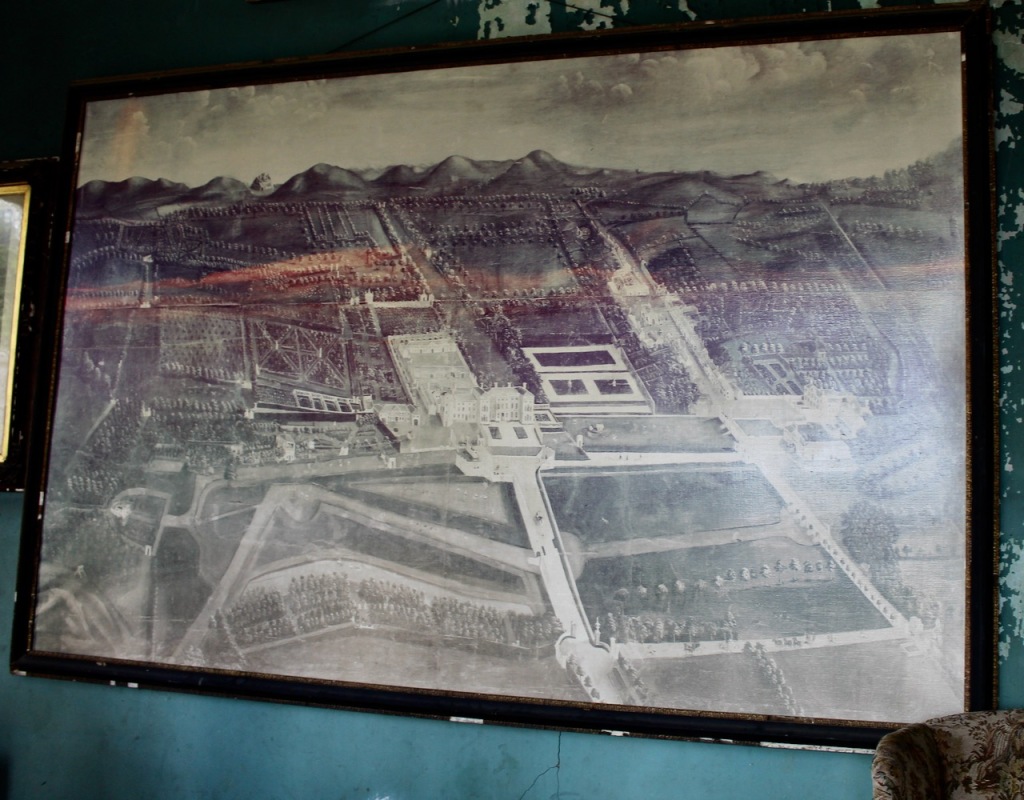
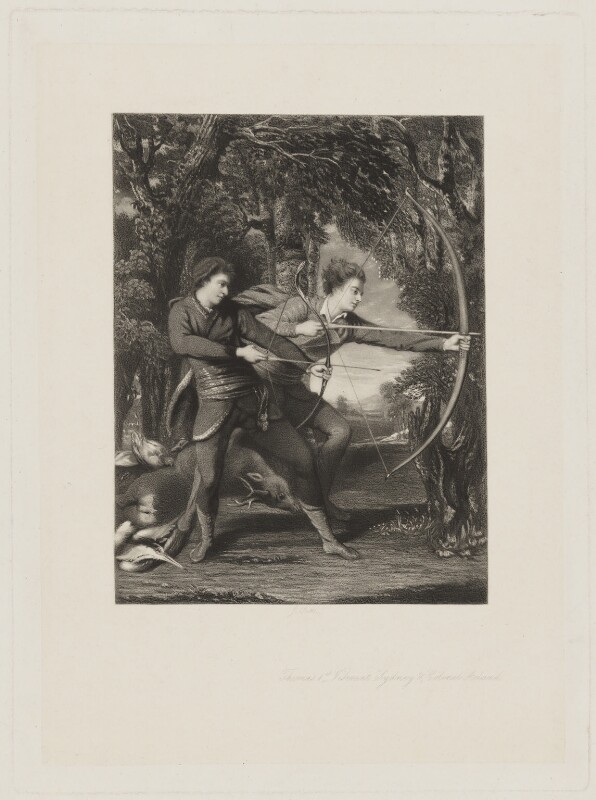
The second (1772) house was enlarged in 1866-69, designed by Sir Charles Lanyon, of Lanyon, Lynn & Lanyon, to form the house which we see today. Lanyon, Lynn & Lanyon also designed Castle Leslie, which we visited – another Section 482 property which is now a hotel. [2]
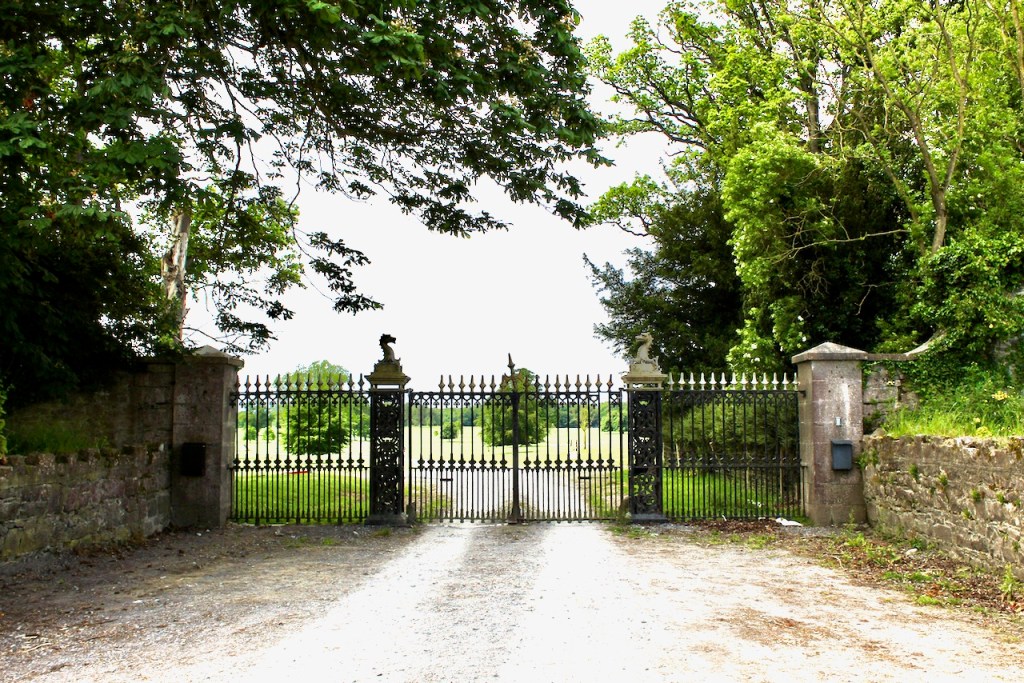
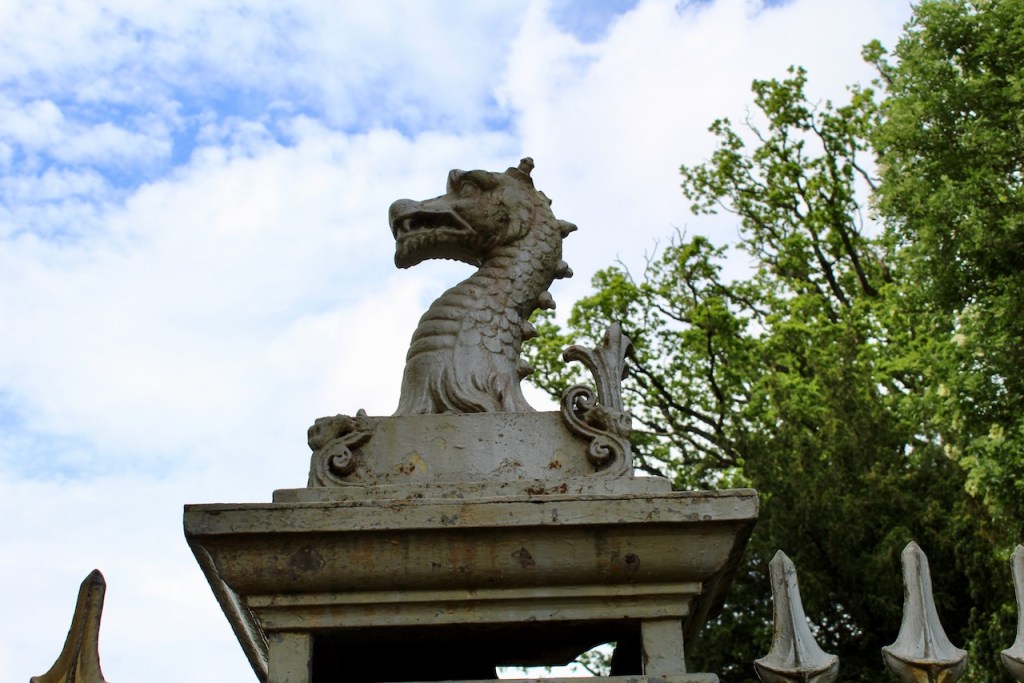
Lt-Col. Dudley Cosby was not the first Cosby to live in Ireland. The Cosby, or Cosbie, family, came to Ireland around 1538, during the reign of Queen Mary (i.e. “Bloody Mary,” the eldest daughter of King Henry VIII, called “Bloody” as she used bloody means to defend the Catholic faith). General Francis Cosby (1510-1580) was an active defender of the Pale in Ireland, the area around Dublin controlled by the British crown, and in 1562 he was granted the site of the Abbey of Stradbally. [3] Francis Cosby married the daughter of the Lord Protector of England, Edward Seymour, the 1st Duke of Somerset. Lord Seymour was the brother of Jane Seymour, wife of Henry VIII. Due to the struggles for power within the court of Henry VIII, Lord Seymour was executed. Francis Cosby came to Ireland at this time. The Abbey, which had been disestablished in Henry VIII’s time (i.e. was taken from the Catholic church and no longer served as an Abbey) became Francis Cosby’s residence, and part of it still exist in the town of Stradbally in a building still called “the Abbey.”
General Francis Cosby died in battle, at the age of seventy, in the battle of Glenmalure in Wicklow, in 1580. He was succeeded by his son, Alexander. Alexander and his son, Francis, continued to fight, engaged in perpetual battle, Major E.A.S. Cosby tells us, with the O’Moores, who had originally controlled the land in the area. In 1596 Anthony O’Moore sent to demand a passage over Stradbally Bridge. Alexander understood this to be a challenge, so he refused passage, and prepared to fight once again, along with his son Francis. That day both Alexander and Francis Cosby were killed, leaving Francis’s nine week old son, William, to inherit. Parts of Stradbally Bridge still exist.
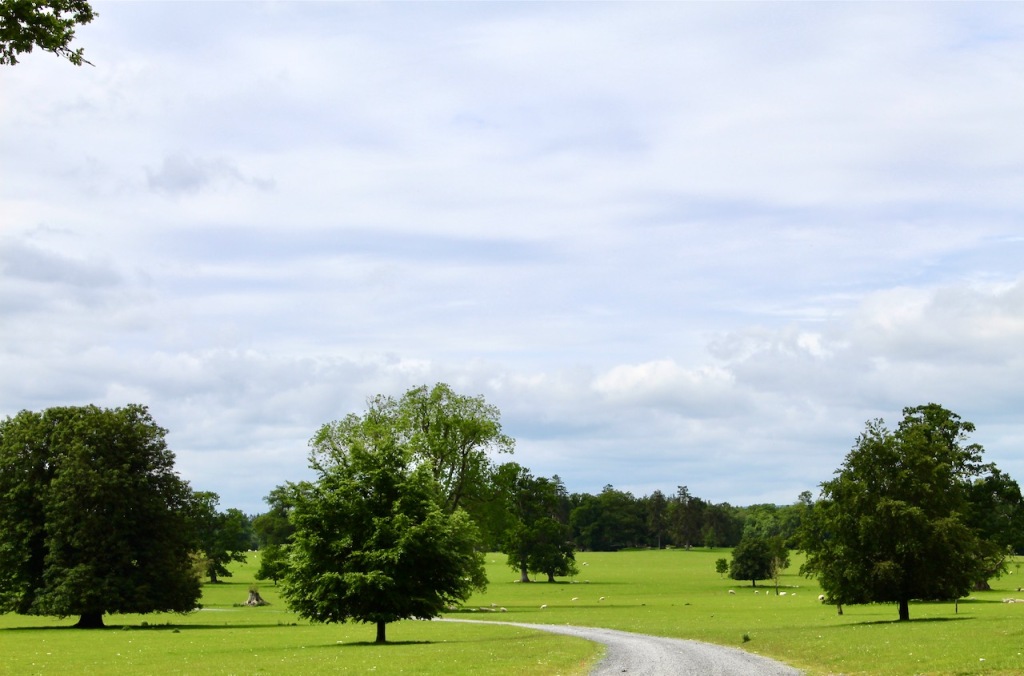
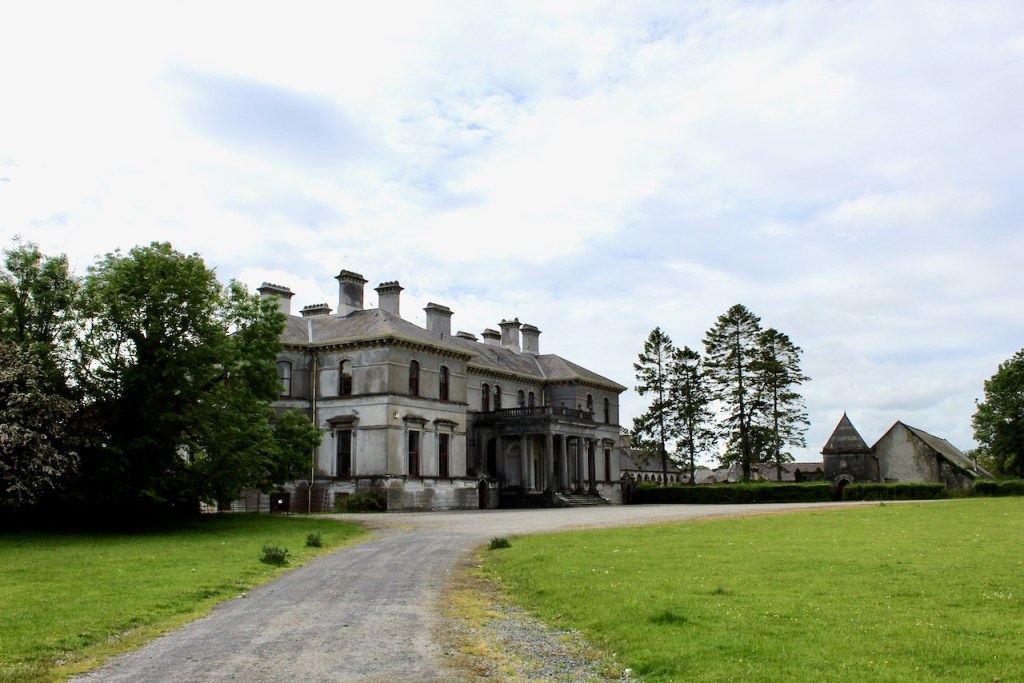
William died at a young age and so his uncle, Richard (d. 1631), inherited the Stradbally estate. Richard challenged the O’Moores to a further fight to avenge his father, and this time he won. Having won one battle each, the fighting seems to have subsided. Richard married Elizabeth Pigott, daughter of the neighbour Robert Pigott of Dysart.
It was Richard’s great-grandson, Lt-Col. Dudley Cosby (1662-1729) who built the house at Stradbally pictured in the 1740 painting. He married Sarah Pole, daughter of Periam Pole (1625-1704) of Ballyfin in County Laois, now a luxury hotel. Her dowry helped pay for the work on the Stradbally estate.
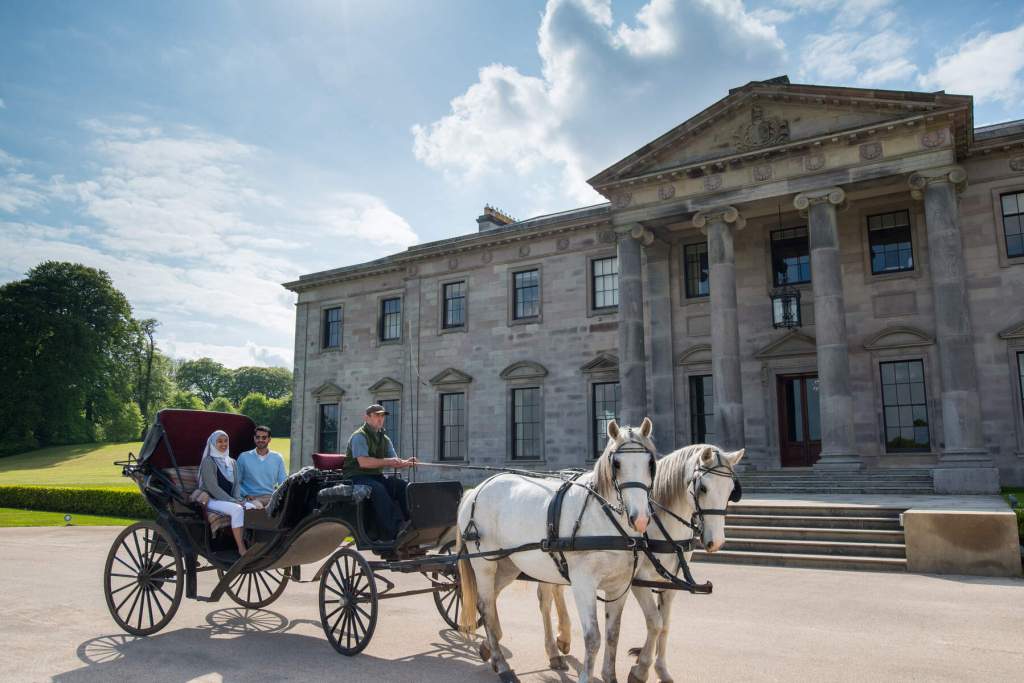
Dudley Cosby created gardens and kept racehorses. His father-in-law did not like this extravagance and gave Dudley £100 not to keep them, which Lt-Col Dudley did not strictly observe!
Dudley and Sarah Cosby had a son whom they named Pole (1703-1766).
Pole Cosby wrote an autobiography. [8] His return from a Grand Tour of Europe is pictured in the 1740 painting in the Billiard Room.
As foreseen by his father-in-law, Dudley Cosby overstretched his finances and he purchased a Captain’s Commission in a military regiment. He leased out Stradbally, and his wife returned to Ballyfin while he was fighting abroad. Her father died but she continued to live with her brother in Ballyfin in the winter and in his house in Queens Street, Dublin, in the summer, for five years. The children were sent to board with a family for schooling and to learn French.
After five years, Dudley and his wife Sarah moved to London “for cheapness” (Pole writes in his autobiography) and then to York. They returned to Stradbally in 1714 in better financial circumstances and Dudley continued to do up the house and garden.
Pole Cosby’s autobiography is very detailed and he writes of the places in which he lived and of his father’s battles in the military, then of his own schooling, listing all of his schoolmates. He also discusses family finances in detail. He writes that his father financed himself at first by marrying Miss Ann Owens daughter of Sir Andrew Owens of the City of Dublin and “with her he got £1500,” then in 1699 he married Sarah Pole and “got with her £2000.” He paid £300 for his Captain Commission and had to pay £100 for his brother Alexander for not finishing his apprenticeship (this Alexander moved to the U.S. along with his brother William).
Pole Cosby went to university in Leyden in Holland, as did several of his Irish cousins. There he was studious and abstemious, he tells us. He travelled while in Europe and was introduced by Lord Townsend to King George I and his son Frederick Prince of Wales. He visited a monastery of Irish priests in Prague and argued with them about religion – they told him he was a heretic and would be damned, but when not talking of religion he says they got along very well!

Pole Cosby married Mary Dodwell and they had a son named Dudley Alexander Sydney Cosby (1732-1774), who served as Ambassador to the Court of Denmark, and for his services, was created Lord Sydney of Leix and Baron of Stradbally, in 1768. When serving as Ambassador to Denmark he helped to arrange the marriage of King George III’s sister to the son of the King of Denmark. It was an unsuccessful marriage and she left her husband for the Prime Minister of Denmark! Despite the lack of success of the marriage he helped to arrange, Dudley Cosby was elevated to the peerage. He married Lady Isabella St Lawrence, daughter of Thomas St Lawrence, 1st Earl of Howth (who lived in Howth Castle – the castle only recently passed out of ownership of the St. Lawrence family).
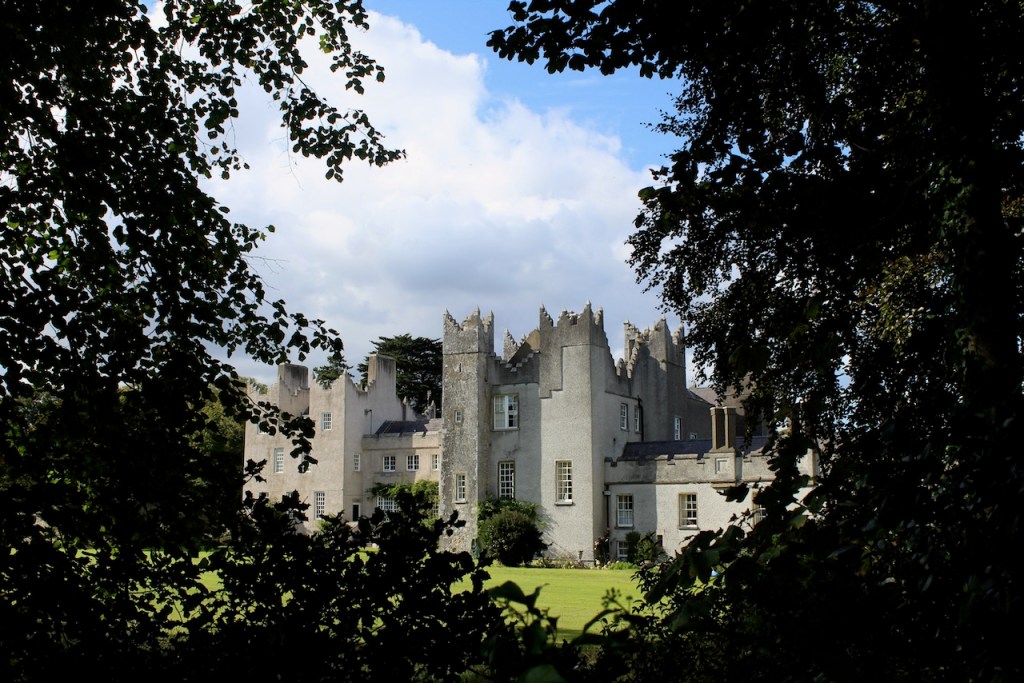
Pole’s son Dudley, Lord Sydney, built the new (current) house, in 1772.
The overseer for the building of the new house was Arthur Roberts, which is stated on a plaque which reads: “Built by Dudley, Lord Sydney, 1772, Arthur Roberts, overseer.”
Dudley Lord Sydney died in 1774, soon after his marriage, and did not have any children. The estate passed to his nephew, son of his brother Alexander, Admiral Phillips Cosby (1729-1808).
The Historic Houses of Ireland website tells us that Dudley died before the house was finished, and his successor Admiral Phillips had to sell 5000 acres to finance the completion. [4]
Phillips’s father, Alexander (d. 1742), was Lieutenant Governor of Annapolis Royal in the United States, and Alexander’s brother William (c.1690-1736) was Governor of New York between 1732-1736.

William’s daughter Elizabeth Cosby married Lord Augustus Fitzroy (1716-1741) and her son, Augustus Henry Fitzroy, 3rd Duke of Grafton, became Prime Minister of England in 1767. After her first husband died Elizabeth née Cosby married James St. John Jefferyes of Blarney Castle in County Cork.
Admiral Phillips Cosby (1729-1808) was born in the United States and was active in the Navy, in which he continued to serve after inheriting Stradbally Hall. He served on the British side in the American War of Independence. He collected many paintings.
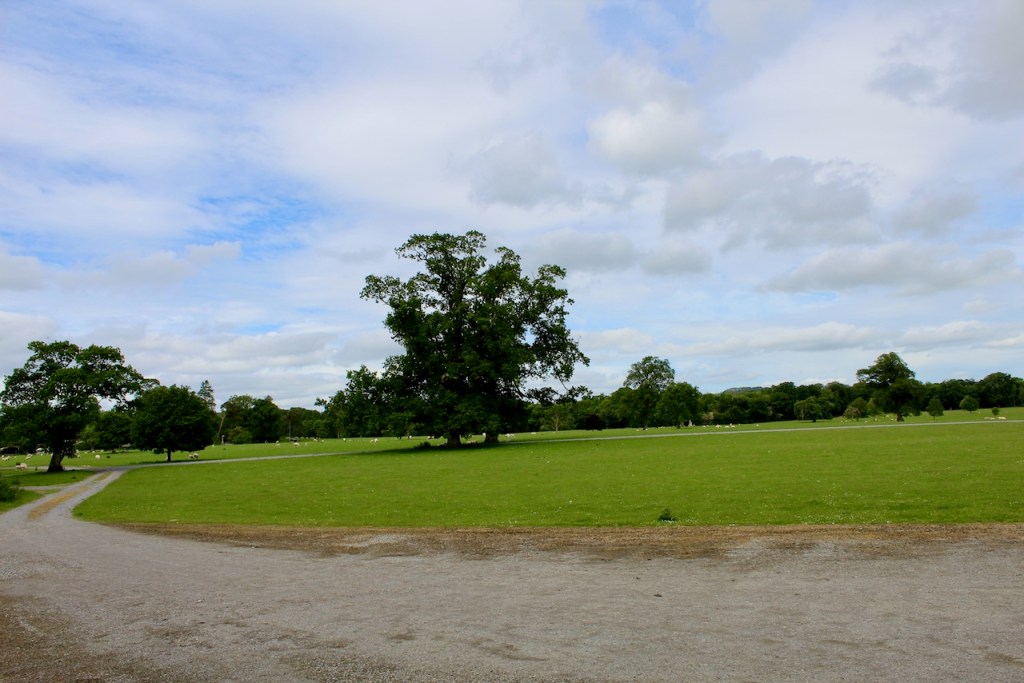
Admiral Phillips had no children, so the estate passed to Thomas Cosby (d. 1798). Thomas was a descendant of Richard Cosby and Elizabeth Pigott. Their son Francis (b. 1612) married Ann Loftus (d. 1673). Francis and Ann née Loftus’s son Alexander (d. 1694) married Elizabeth L’Estrange and their son was Lt-Col. Dudley Cosby (1662-1729) who built the house at Stradbally.
When the Cosby line died out with Admiral Phillips Cosby (1729-1808), it was a descendant of Francis and Ann née Loftus’s Thomas (d. 1713) rather than their son Alexander, who inherited. Thomas Cosby (d. 1713) lived at Vicarstown, Stradbally, County Laois. He married Elizabeth Smith, and they had a son, Francis (d. 1783). Francis married Ann Pigott and they had several children. The Thomas who inherited was a son of their son Thomas (b. 1742), and Frances Bowker.
Thomas Cosby (1765-1798) married Grace Johnstone, daughter of George of Glaslough, County Monaghan.
Stradbally passed to his son Thomas (d. 1832). Thomas (d. 1832) was High Sheriff of Queen’s County in 1809 and also Governor of Queen’s County. He married Charlotte Elizabeth Kelly of Kellyville, County Laois. The property passed via their son Thomas Phillips, who died in 1851. He served as High Sheriff, Deputy Lieutenant and Justice of the Peace for Queen’s County.
The property passed on down to via Thomas Phillips Cosby’s brother Sydney Cosby (who had died in 1840) to Sydney’s son, Colonel Robert Cosby (1837-1920). Sydney Cosby had married Emily, the daughter and co-heir of Robert Ashworth of Shirley House, Twickenham (his brother Wellesley Pole Cosby had married the other daughter and co-heiress, Marie).

Colonel Robert Cosby employed Charles Lanyon in 1866 to enlarge the house, remodelling it in an Italianate style. He inherited a fortune, and built houses in the nearby village of Stradbally, following in the footsteps of his forebears who had also sought to develop the village.
Stradbally passed to his son, also in the military, Captain Dudley Cosby (1862-1923), and to his son, Major Ashworth Cosby (1898-1984). Major Ashworth married Enid Elizabeth Hamilton from nearby Roundwood, County Laois.

It was Major Ashworth’s grandson, Thomas, who showed us around the house. Thomas’s young son joined us in the Billiard room to look at the old painting of Stradbally, and asked a few intelligent questions, so he is learning the history of his home also!
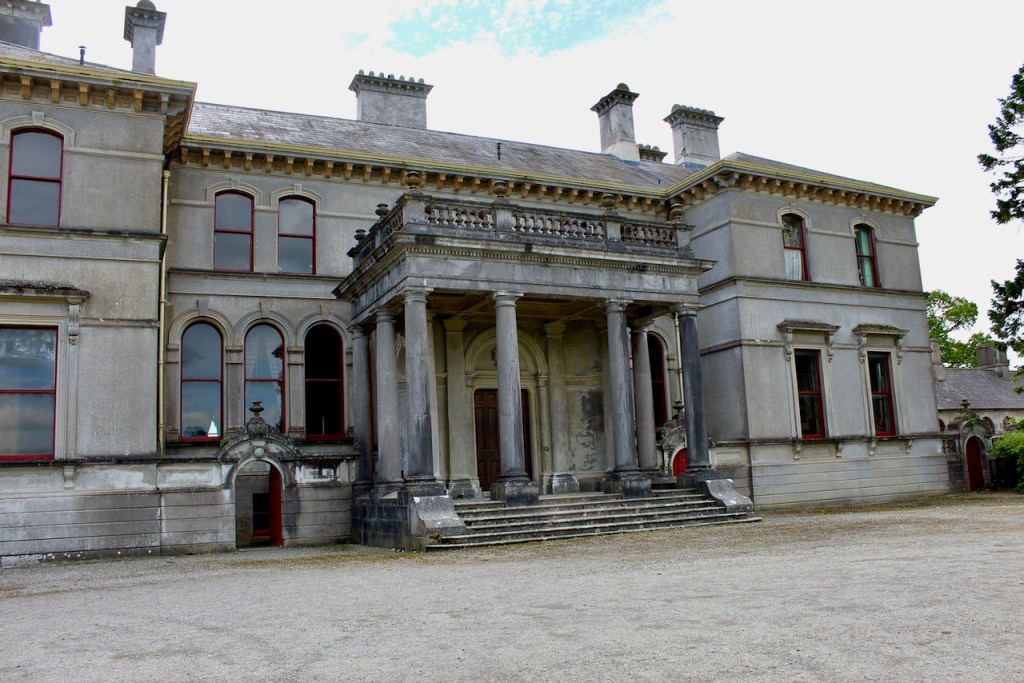
Mark Bence-Jones tells us that Lanyon added a new entrance front, which was advanced from the old front wall so that the house became three rooms deep instead of two. This front has an impressive single-storey balustraded Doric portico leading up a flight of stone steps to the front door. On either side of the portico are a group of three round-headed windows, and beyond those on either side, a two-bay block projecting forward.
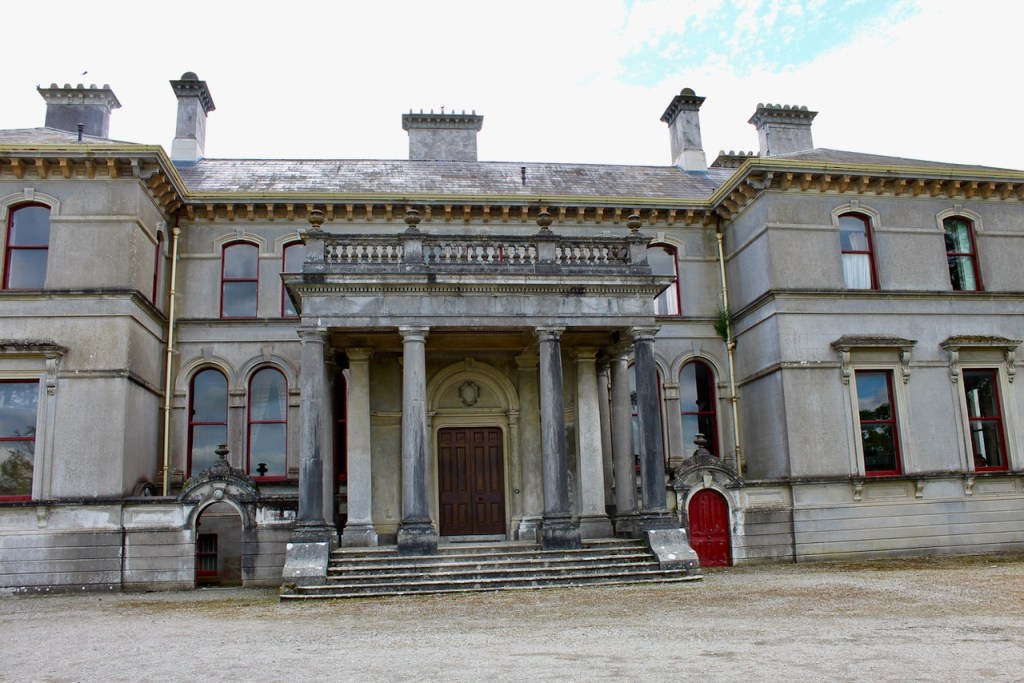
The upper storey windows are what Bence-Jones describes as “camber-headed” (he defines camber-headed windows as a window of which the head is in the form of a shallow convex curve). [5]
The house was given a high-pitched eaved roof on a bracket cornice.
After our tour of the house, we walked around to the back of the house as I wanted to see what Bence-Jones had described: “On the garden front, Lanyon left the two three sided bows, but filled in the recessed centre with a giant pedimented three arch loggia.” It is impressive! According to the National Inventory of Architectural Heritage, this was originally the front of the house, but when the three arches were added, so was the Doric portico on what is now the entrance front, so this impressive two storey over basement treble arch was never intended, it seems, as an entry to a front door! [6]
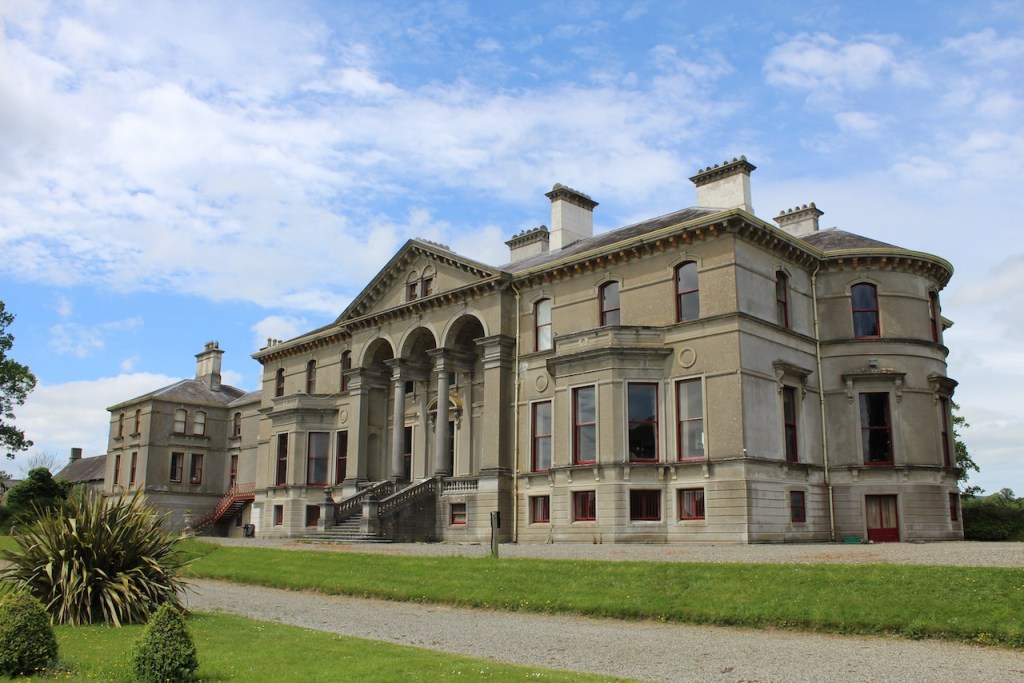
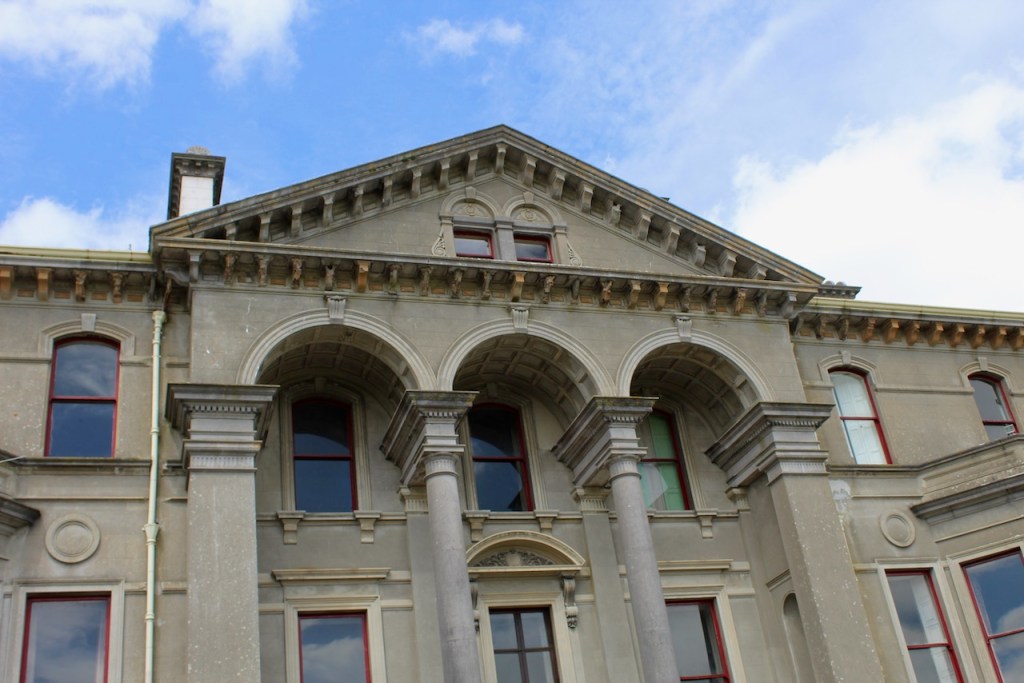
The arches extend into shallow barrel-vaults with well-executed coffering. The door into the garden has an arched pediment over it on brackets. [7]
The side of the house has a bow in the centre, and rectangular windows with entablatures on console-brackets over them.
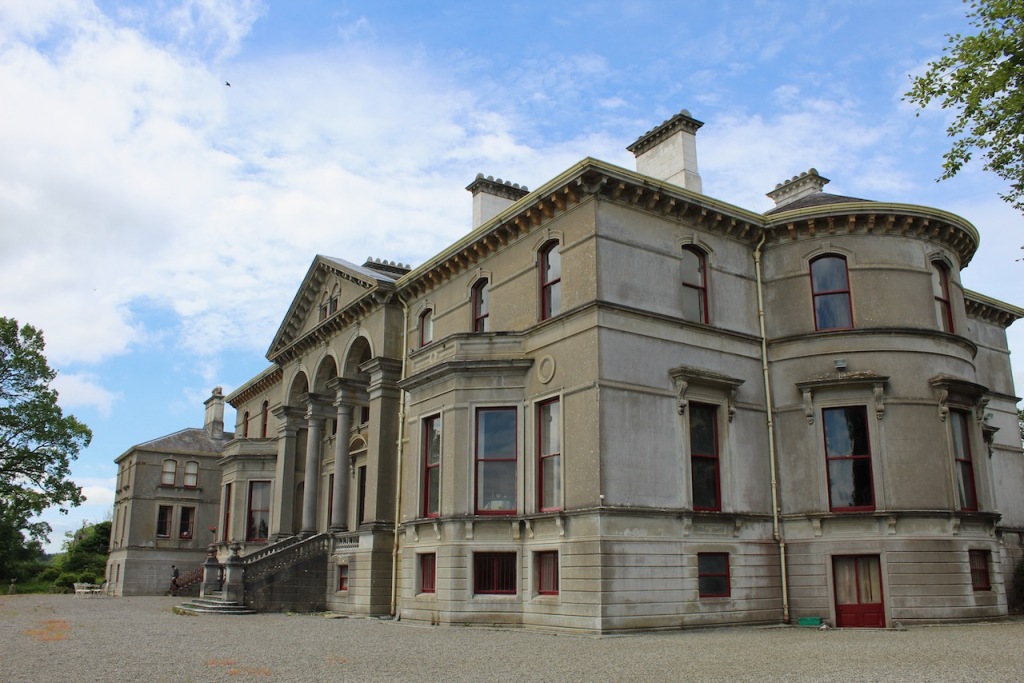
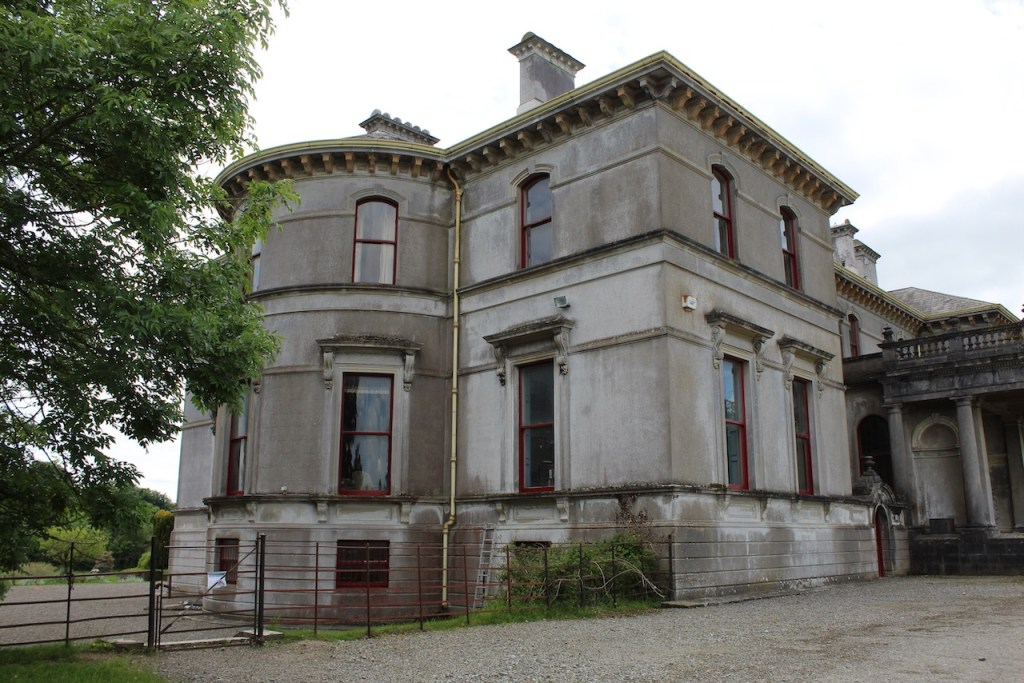
The other end of the house is a slightly lower two storey over basement “bachelor’s wing” (this may have been used for visiting single gentlemen.)
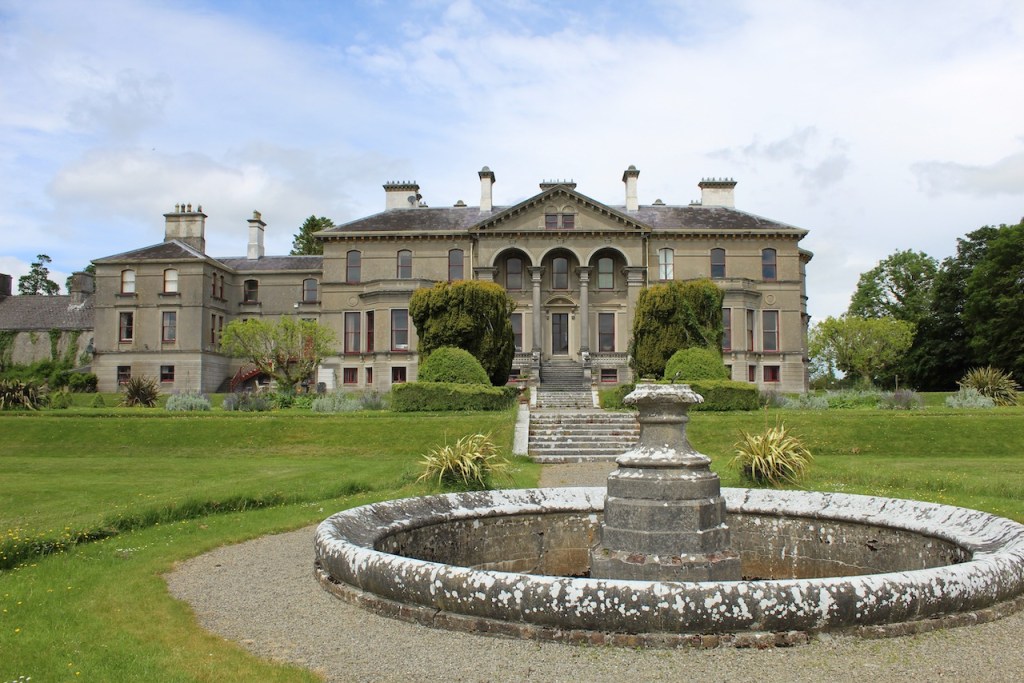
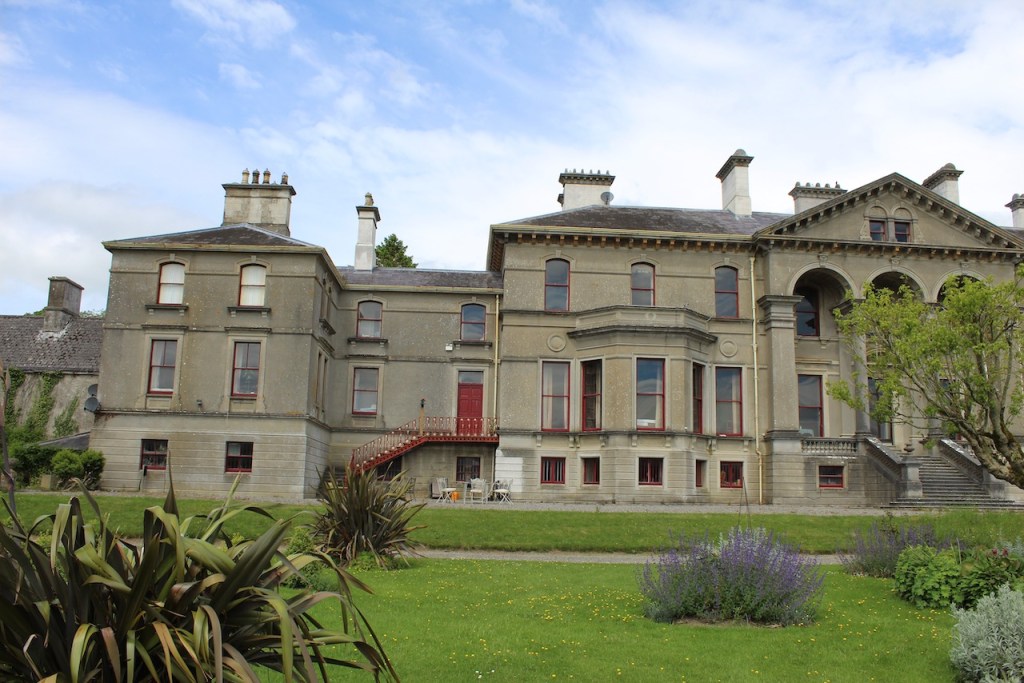
But let us go around to the front again. The sides of the Doric portico hold niches.
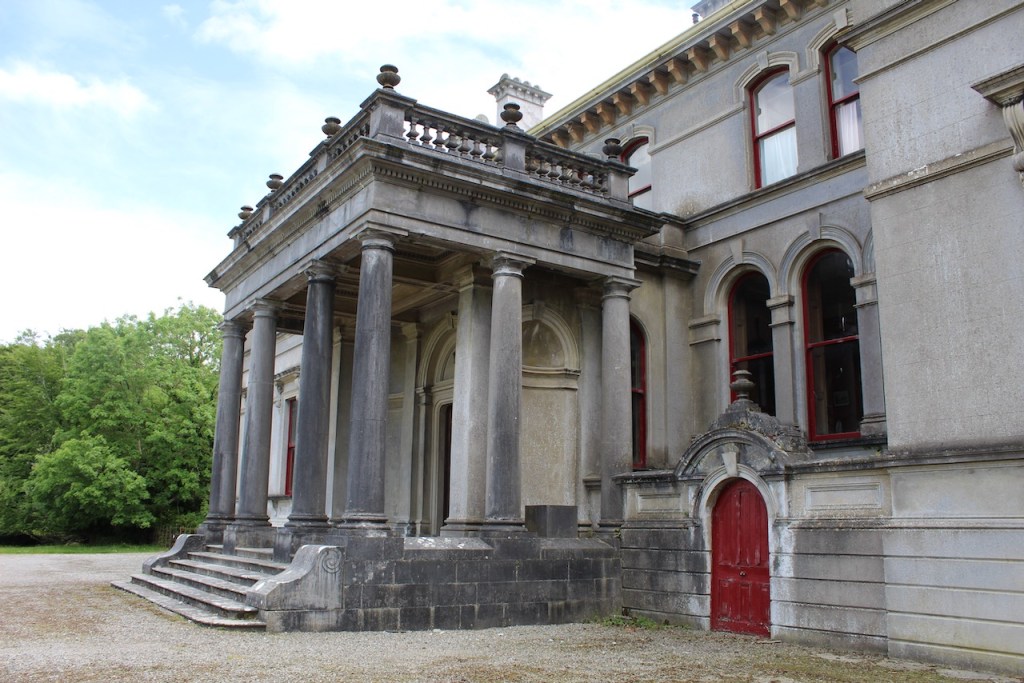

I love the little doors at either side of the Doric portico.

In the Doric portico is a round-headed door opening and timber panelled double door with overpanel.
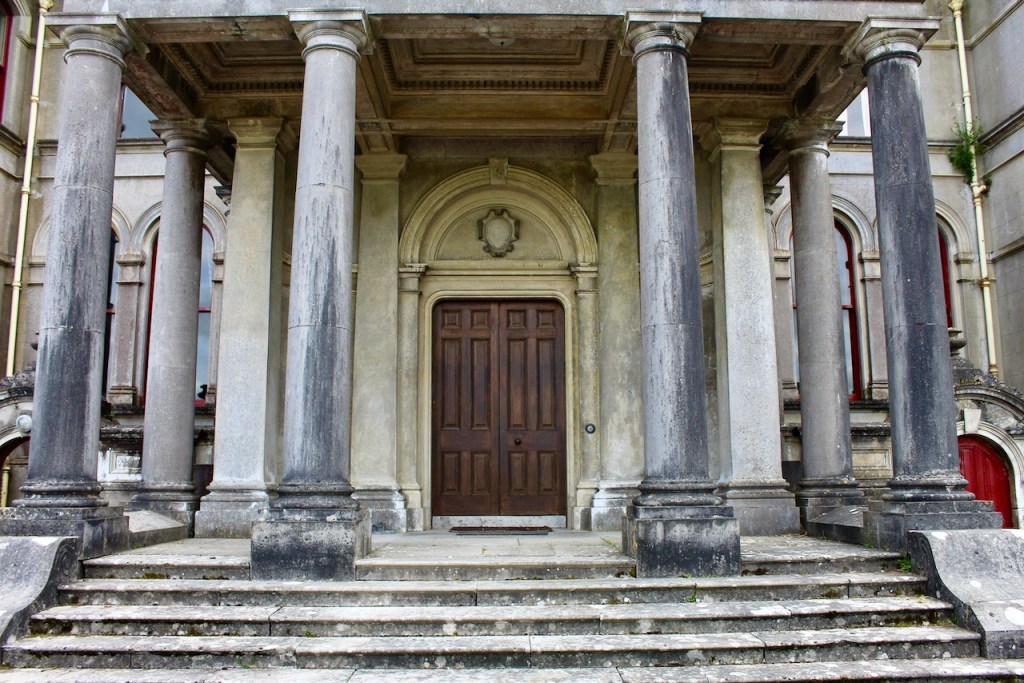

The door leads into an entrance hall with a vaulted ceiling and a flight of steps up to the level of the principal storey.

We went first to the billiard room on our right (the newer, Lanyon designed part of the house) to see the large painting of old Stradbally. From the billiard room you have a good view of the beautiful cut-stone farm buildings.
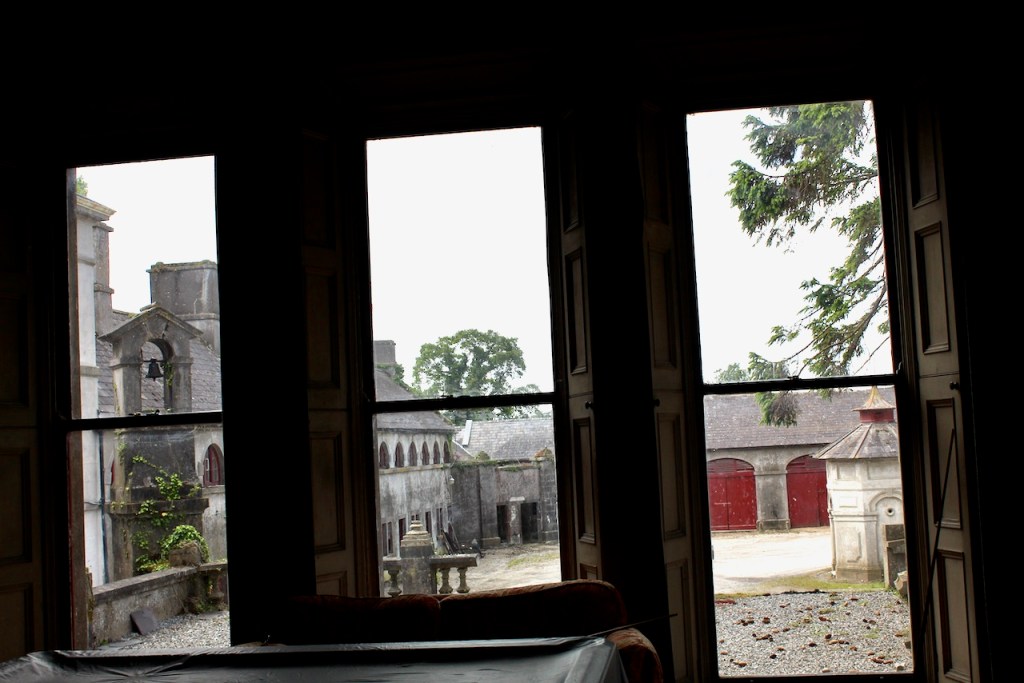
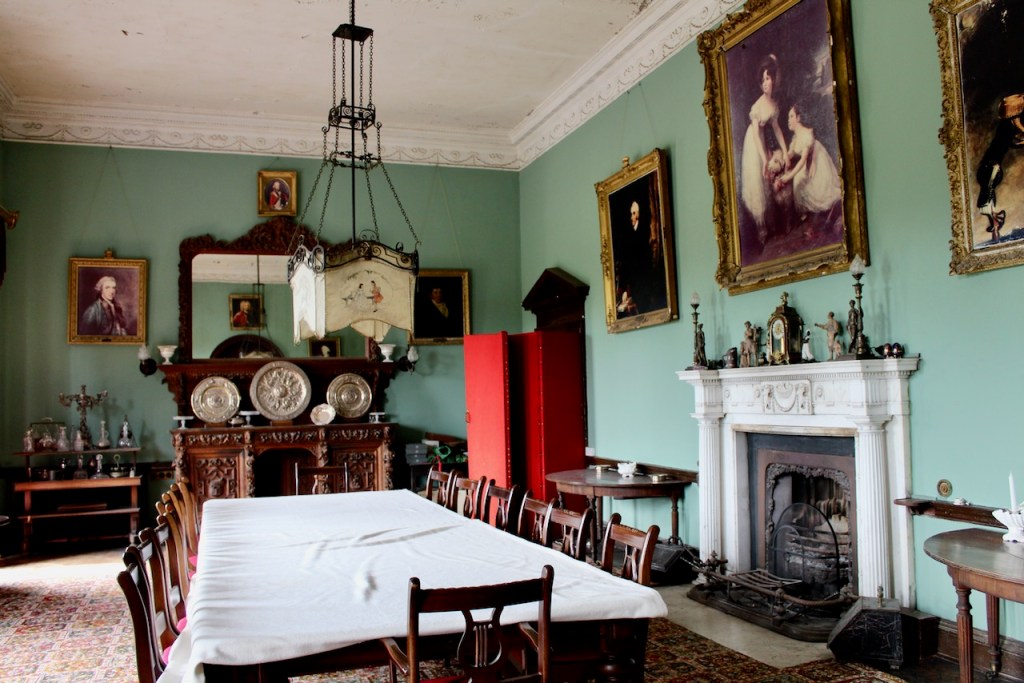
The three reception rooms on the garden front, the dining room, saloon and drawing room, remain much as they were before the Lanyon renovation, with late-Georgian plasterwork.
I admired the beautiful lamp shade over the dining table, and the plasterwork ceiling, which the National Inventory describes as “Adamesque” (ie. like the work of William Adams and his sons, most famous of whom are Robert and James). Andrew Tierney in his Buildings of Ireland describes the frieze of swags “framing calyxes and paterae”, and a “guttae cornice.” Patera is a round or oval ornament in shallow relief, and calyxes are the whorls of a plant that encloses the petals and forms a protective layer around a bud. A guttae is one part of a post-and-lintel structure.
The ceiling centrepiece is of acanthus, anthemion and circles of laurel interweaving around a ribbon-and-reed moulding.
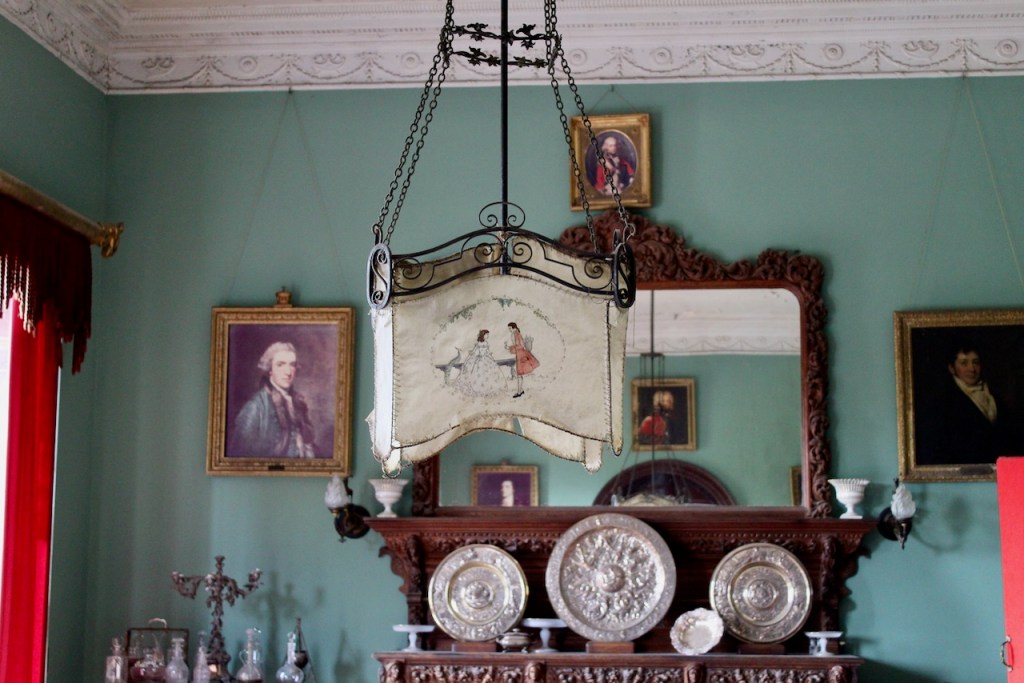
In the dining room are several portraits. There is one of William Wellesley-Pole, 3rd Earl of Mornington. He inherited from William Pole of Ballyfin and added Pole to his surname. He was the elder brother of the Duke of Wellington. Their grandfather, the 1st Baron of Mornington, was born Richard Colley, and he inherited from his cousin and took the name Wesley, which was later changed to Wellesley. His sister Anne Colley married William Pole, of the Poles of Ballyfin. Another portrait is of Captain Thomas Cosby of the Royal Horse Guards; and another of Emily and Marie Ashworth by Sir Thomas Laurence. Elsewhere in the house, are portraits of Dudley Cosby Lord Sydney; the Prime Minister Augustus Henry Fitzroy, 3rd Duke of Grafton; and George Earl of Halifax (William Cosby who was the Governor of New York married Grace Montagu, sister of the 1st Earl of Halifax).


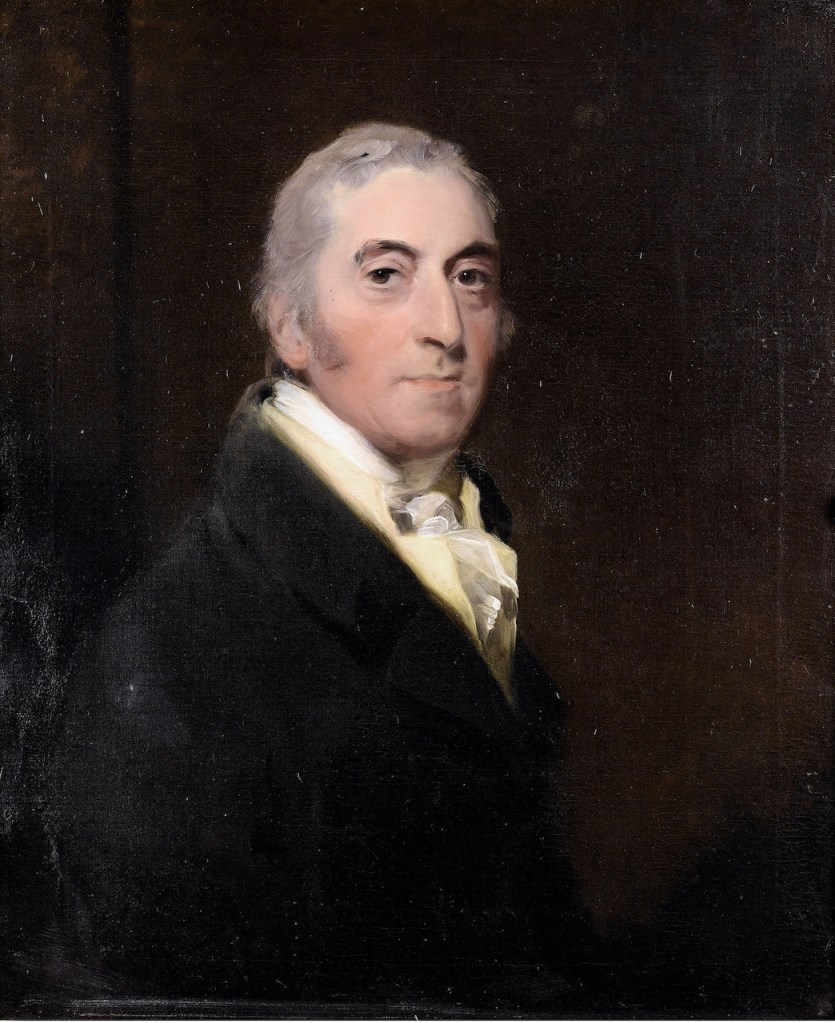
From the Dining Room we went into the Saloon.

The stuccowork is carefully coloured with pale blue and salmon red, and there is paintwork on the ceiling:
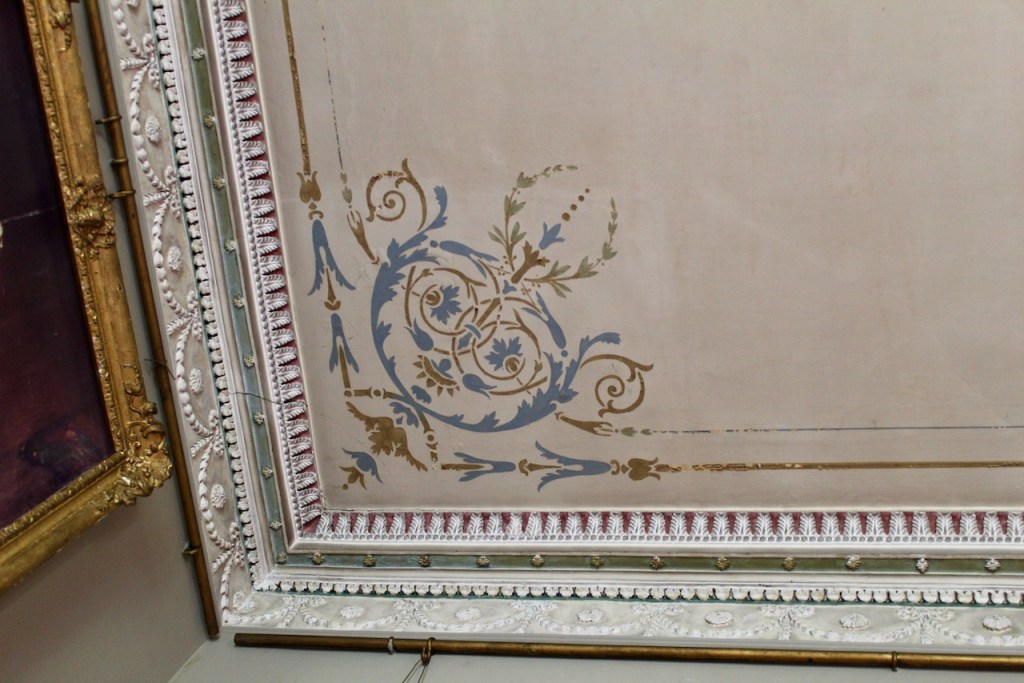
The next room had a ceiling that took my breath away. It has a delicate band of acanthus fronds and an outer band of husks. Andrew Tierney describes also the gilded rinceau freize, in his Buildings of Ireland: Central Leinster. This is a frieze of leafy scrolls branching alternately to left and right. The walls have a Victorian paper in a gilt diamond pattern.
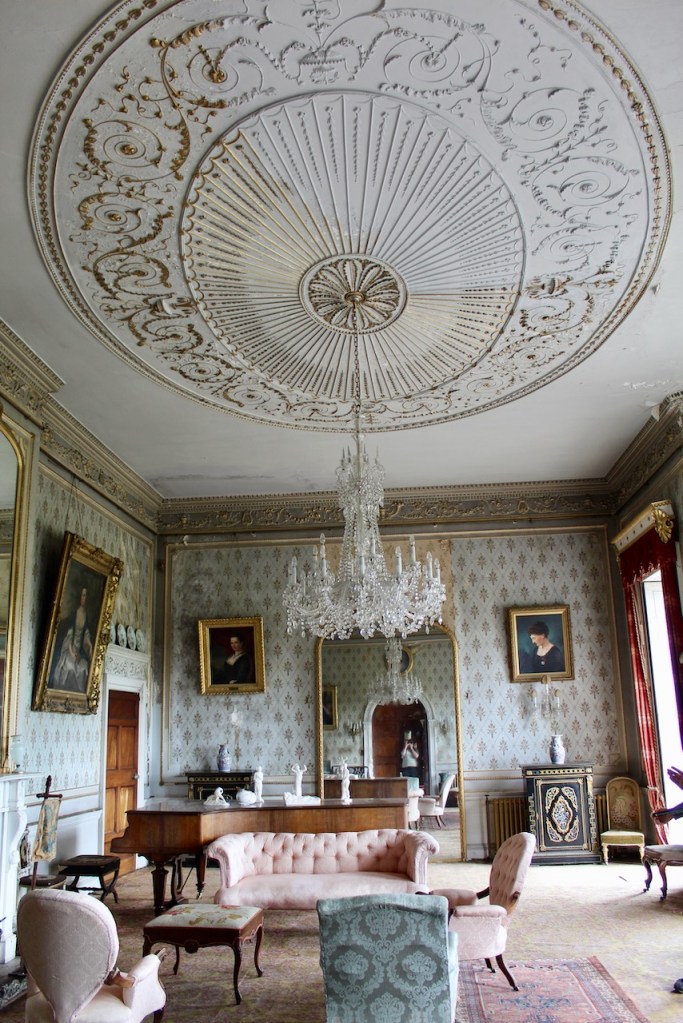
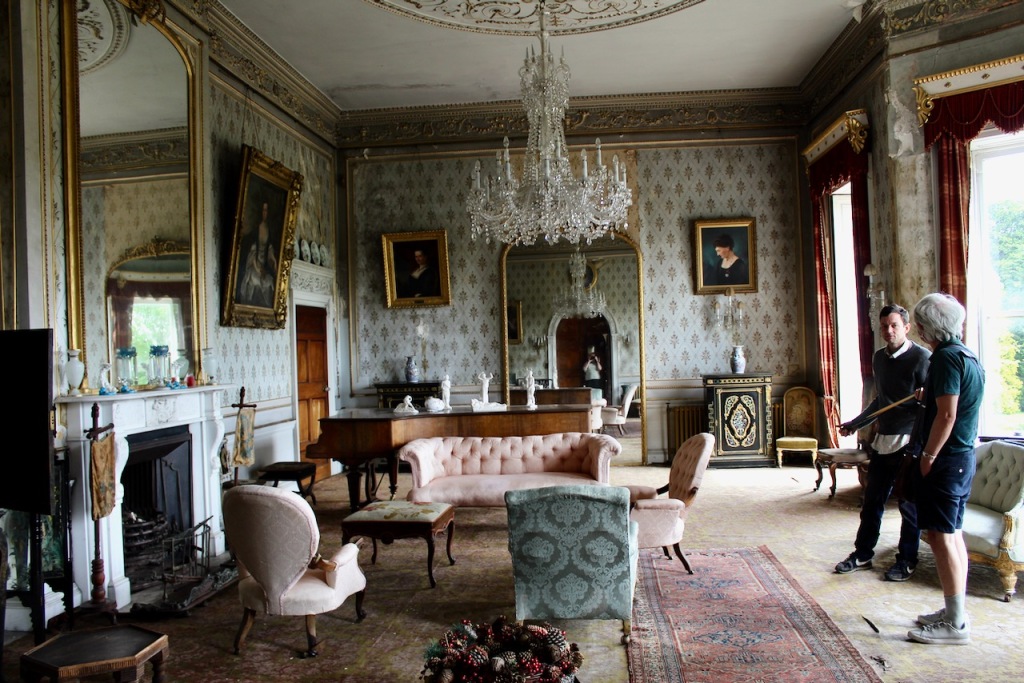
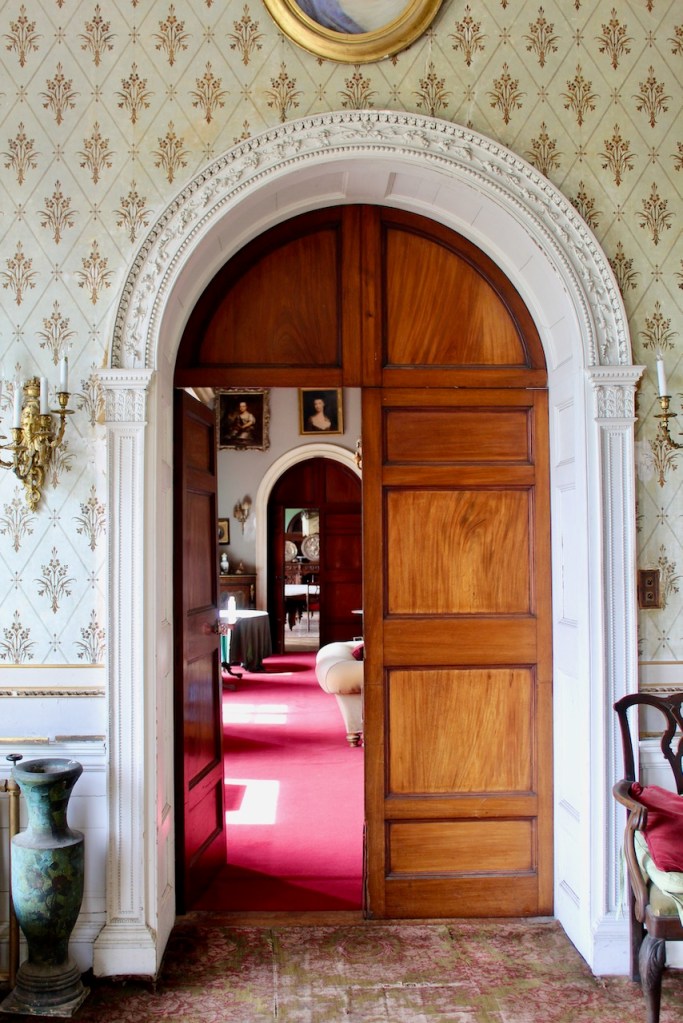
The ballroom, as Bence-Jones calls it, now the library, one of the additional rooms formed 1866-69, extends into the bow at the end of the house. It has a ceiling decorated with panels of early C19 pictorial paper in grissaille, i.e. painting using a palette of greys, or “gris” in French. There is a pink egg and dart and dentil cornice around the ceiling, and patterning similarly painted in the ceiling rose.

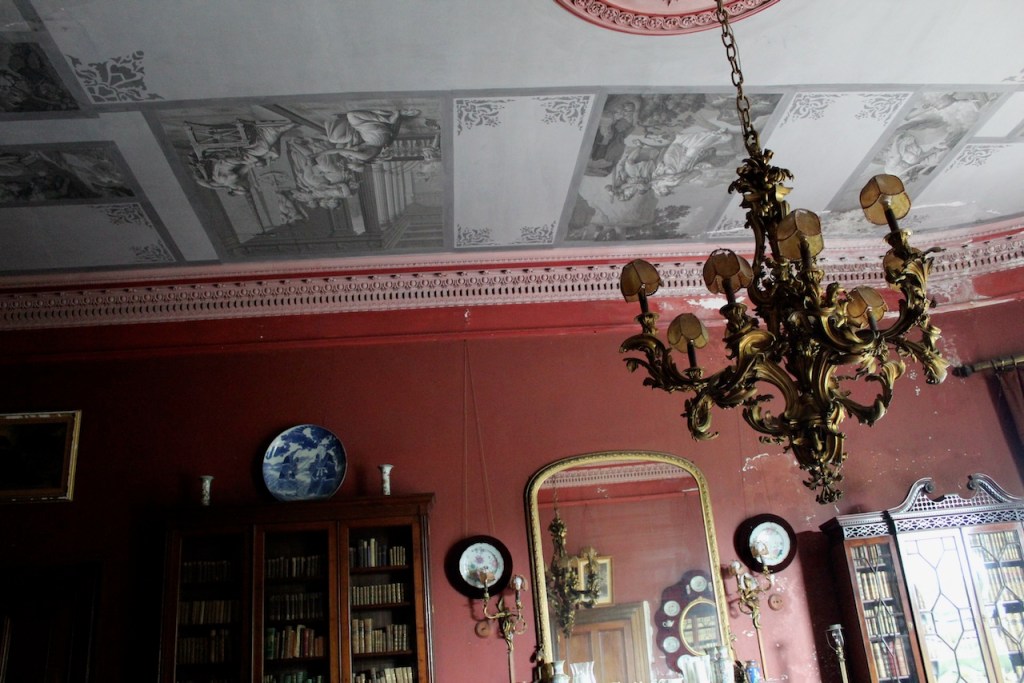

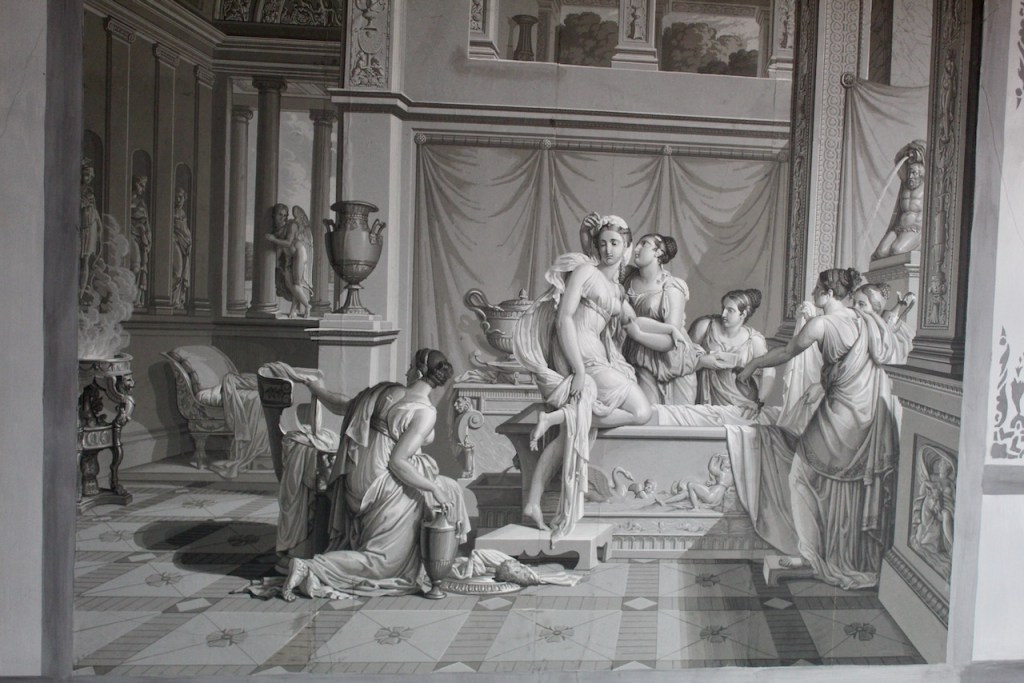
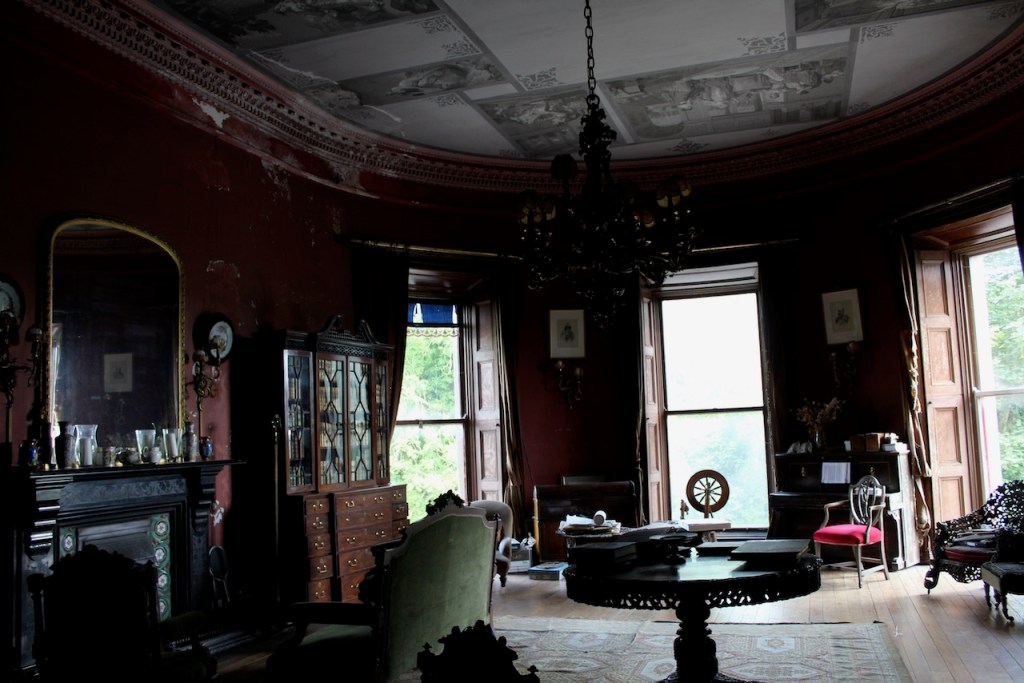
Back to the front of the house, is the study, on the other side of the front hall from the billiards room.
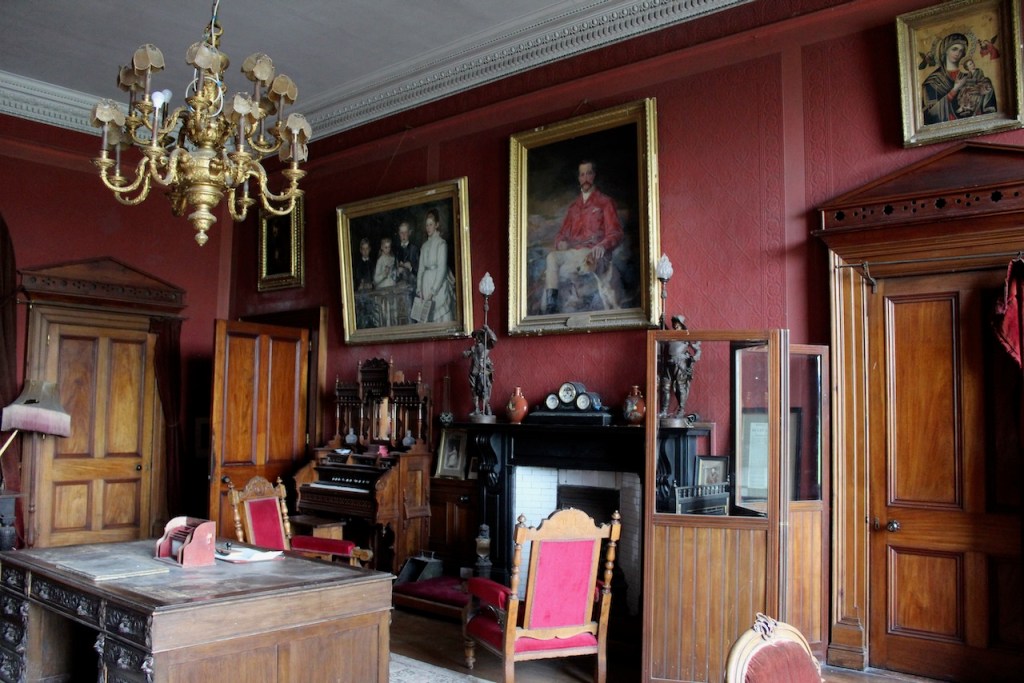
Amazing as the house is so far, the best is yet to come: the front hall leads to the stairwell. The former entrance hall, which keeps its eighteenth century chimneypiece, was made by Lanyon into a central top-lit staircase hall. The staircase is of Victorian oak joinery and leads up to a long picture gallery. This occupies the centre of the house, and is sixty feet in length and twenty in breadth, and is surmounted by an elaborate coffered and ornamented barrel-vaulted ceiling with glass roof of panels set in steel frame.

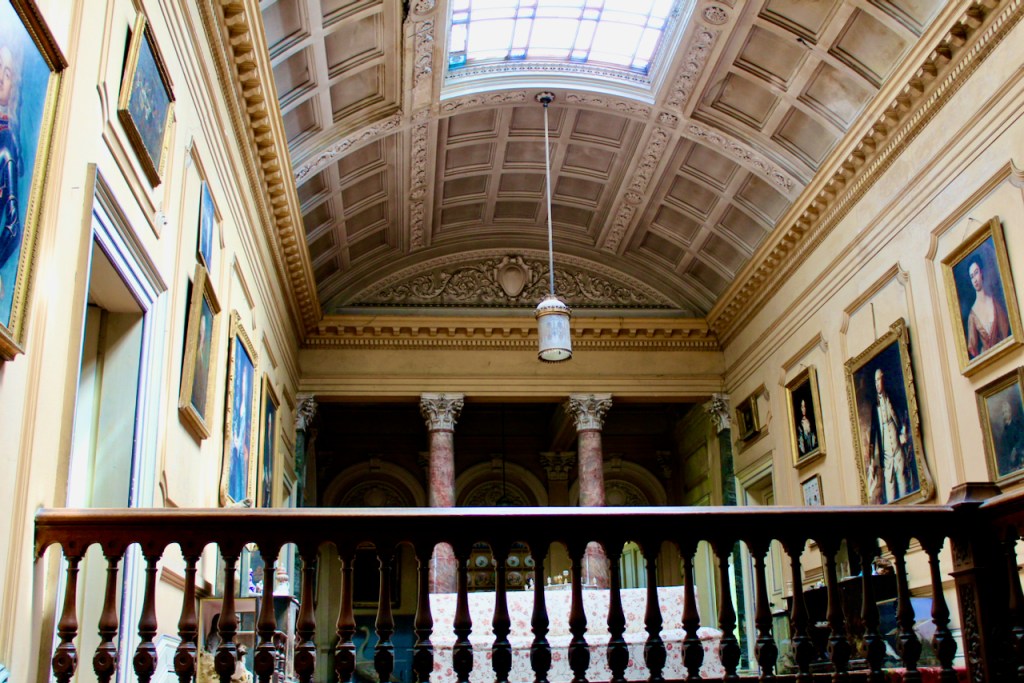
The gallery is flanked by narrow passages from which open the bedrooms. At the western end is a small lobby separated from the main portion by two pink marble Corinthian pillars, above which is an architrave decorated with a bold design in stucco.

After seeing the house, we went outside to wander around the gardens. The garden front looks on to Italianate gardens, laid out in 1867 by Maurice Armour.
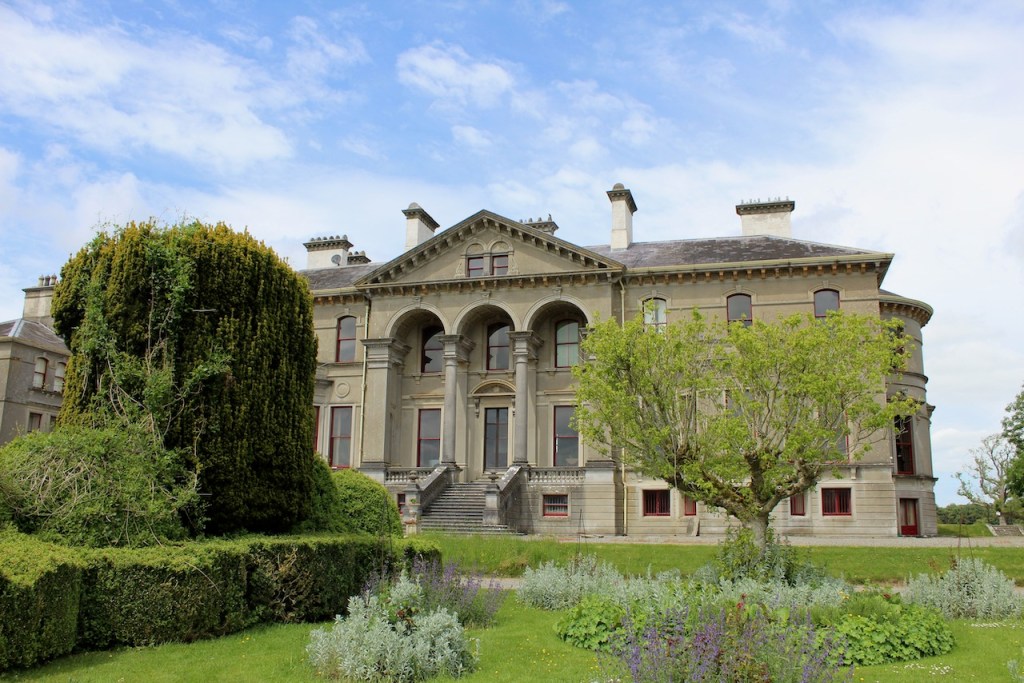
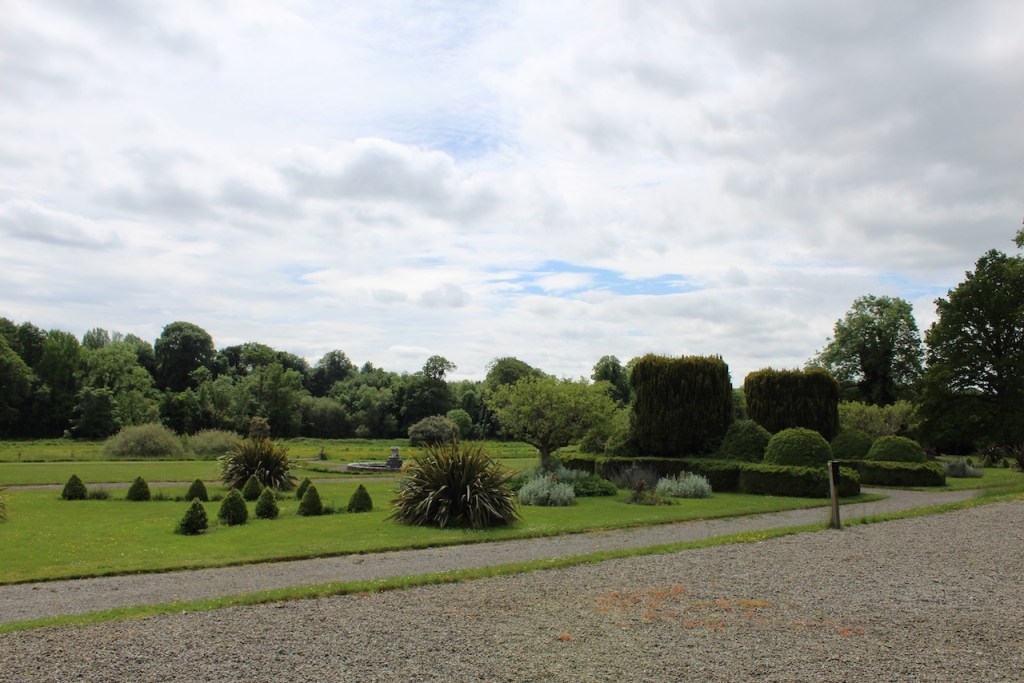
There are also lovely walks around, of which we didn’t properly avail – we must have been tired!
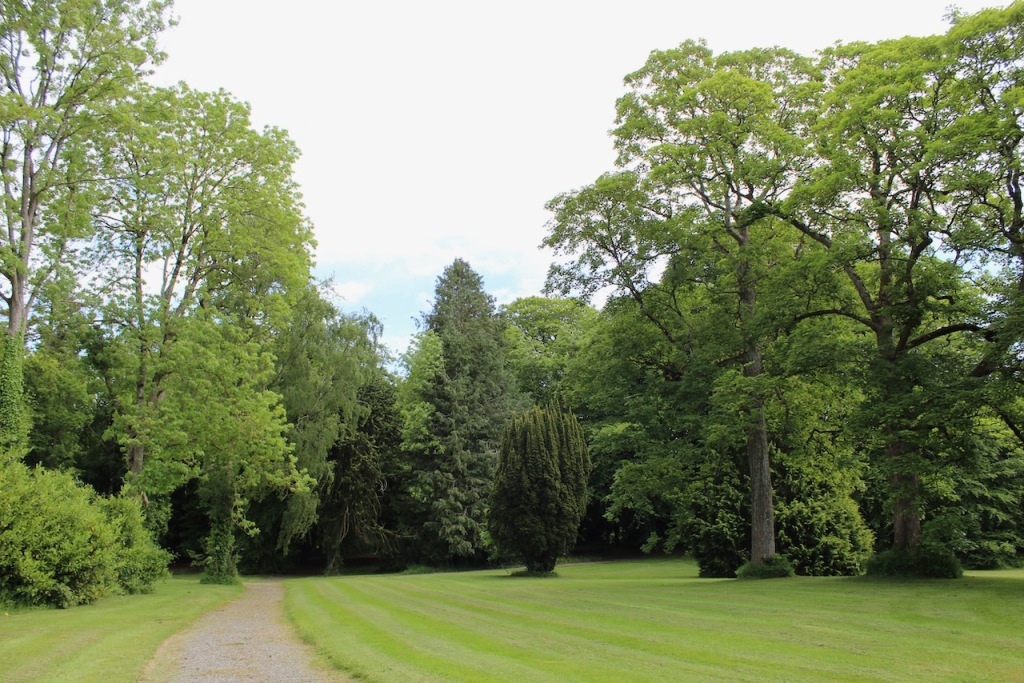
There’s a lake on the property, and tennis court.
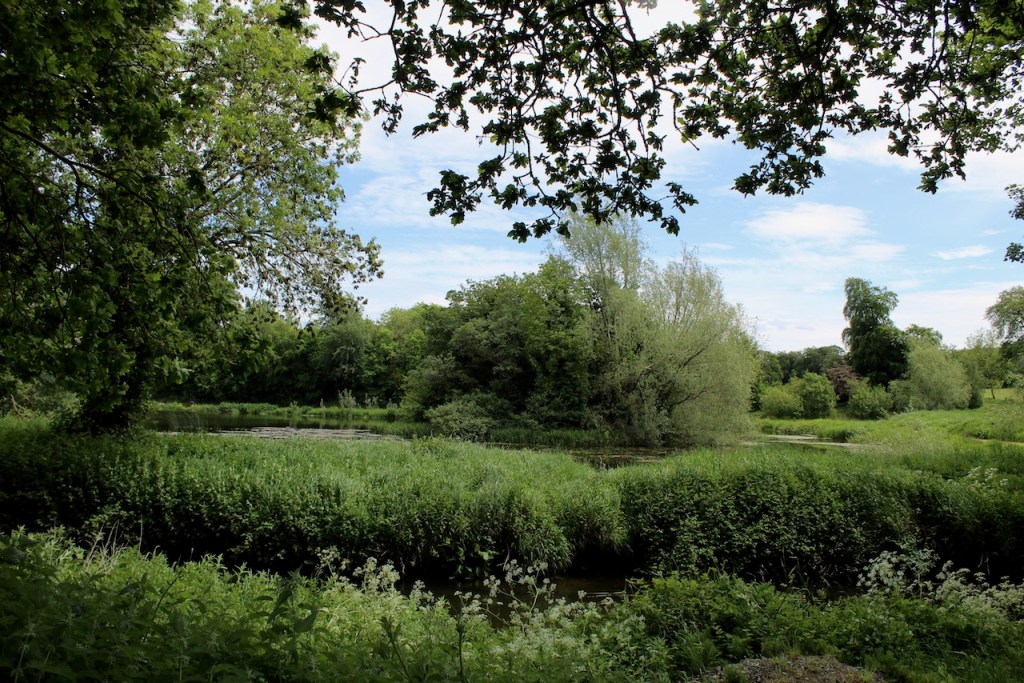
The stable complex matches the house, and was also designed by Lanyon, Lynn & Lanyon.
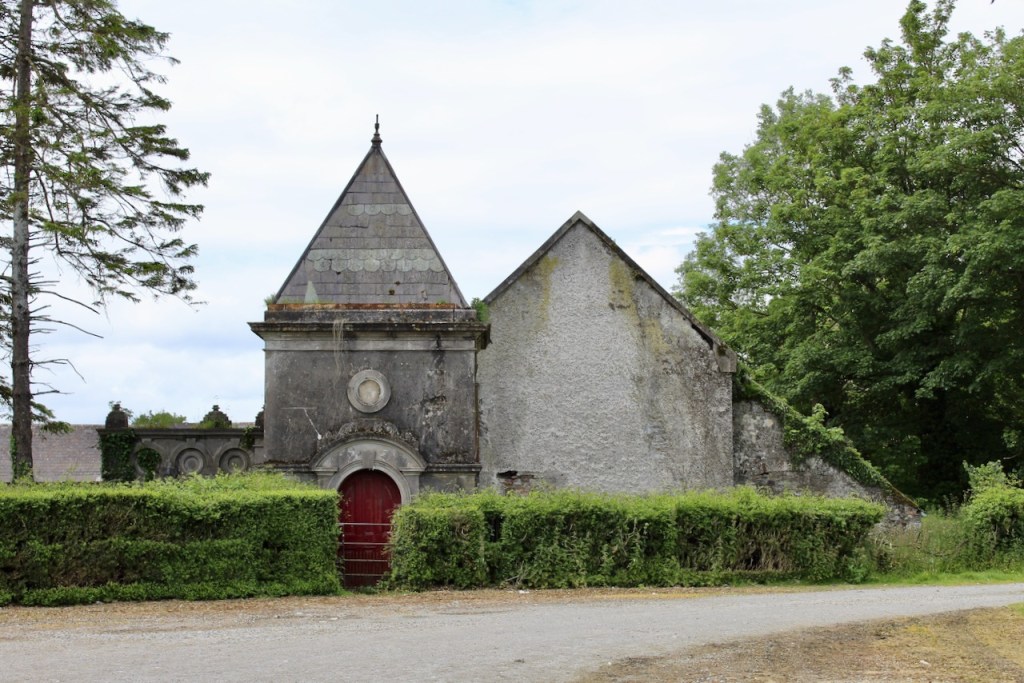

Inside the stable courtyard is a pretty little building, a well house with blind recessed arches and raised ornamental panels:
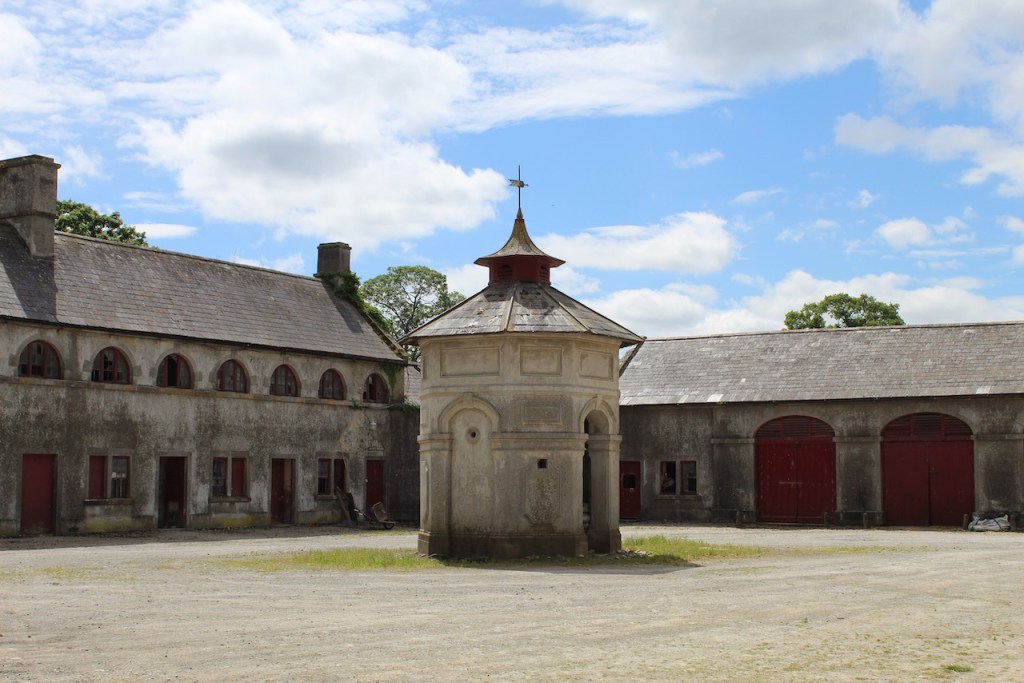

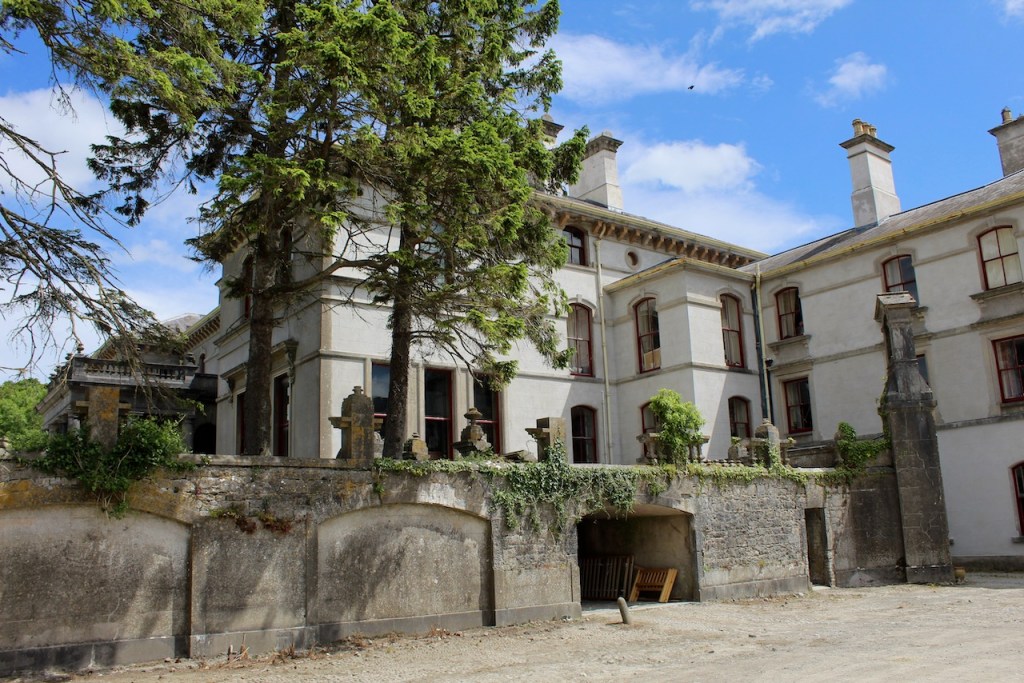

[1] p. 265. Mark Bence-Jones. A Guide to Irish Country Houses (originally published as Burke’s Guide to Country Houses volume 1 Ireland by Burke’s Peerage Ltd. 1978); Revised edition 1988 Constable and Company Ltd, London.
[2] https://irishhistorichouses.com/2020/08/07/castle-leslie-glaslough-county-monaghan/
[3] see the Stradbally Hall website, and the history of the house, written by Major E.A.S. Cosby in 1951. https://www.stradballyhall.ie/history/
[4] https://www.ihh.ie/index.cfm/houses/house/name/Stradbally%20Hall
[5] https://irishhistorichouses.com/2020/04/18/architectural-definitions/
[7] p. 598. Tierney, Andrew. The Buildings of Ireland: Central Leinster. Kildare, Laois and Offaly. Yale University Press, New Haven and London, 2019.
[8] Autobiography of Pole-Cosby of Stradbally, Queen’s County (1703-1766) originally published in the Journal of the Co Kildare Archæological Society and Surrounding Districts, Vol V, 1906-1908.
https://www.ornaverum.org/reference/pdf/183.pdf
[9] https://www.irelandscontentpool.com/en/media-assets/media/52026
[10] p. 600. Tierney, Andrew. The Buildings of Ireland: Central Leinster. Kildare, Laois and Offaly. Yale University Press, New Haven and London, 2019.
[11] see https://theirishaesthete.com/2020/02/22/dancing-on-the-ceiling/
for more information about these pictures.